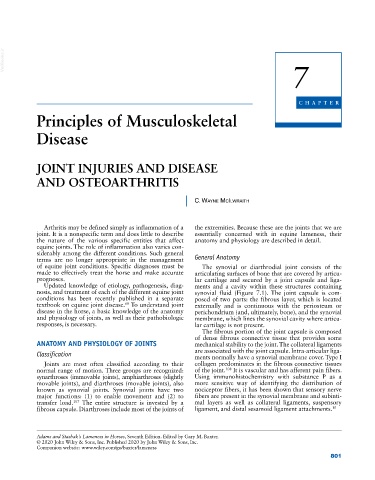Page 835 - Adams and Stashak's Lameness in Horses, 7th Edition
P. 835
VetBooks.ir
7
CHAPTER
Principles of Musculoskeletal
Disease
JOINT INJURIES AND DISEASE
AND OSTEOARTHRITIS
C. Wayne MCIlWraIth
Arthritis may be defined simply as inflammation of a the extremities. Because these are the joints that we are
joint. It is a nonspecific term and does little to describe essentially concerned with in equine lameness, their
the nature of the various specific entities that affect anatomy and physiology are described in detail.
equine joints. The role of inflammation also varies con
siderably among the different conditions. Such general
terms are no longer appropriate in the management General Anatomy
of equine joint conditions. Specific diagnoses must be The synovial or diarthrodial joint consists of the
made to effectively treat the horse and make accurate articulating surfaces of bone that are covered by articu
prognoses. lar cartilage and secured by a joint capsule and liga
Updated knowledge of etiology, pathogenesis, diag ments and a cavity within these structures containing
nosis, and treatment of each of the different equine joint synovial fluid (Figure 7.1). The joint capsule is com
conditions has been recently published in a separate posed of two parts: the fibrous layer, which is located
68
textbook on equine joint disease. To understand joint externally and is continuous with the periosteum or
disease in the horse, a basic knowledge of the anatomy perichondrium (and, ultimately, bone), and the synovial
and physiology of joints, as well as their pathobiologic membrane, which lines the synovial cavity where articu
responses, is necessary. lar cartilage is not present.
The fibrous portion of the joint capsule is composed
of dense fibrous connective tissue that provides some
ANATOMY AND PHYSIOLOGY OF JOINTS mechanical stability to the joint. The collateral ligaments
are associated with the joint capsule. Intra‐articular liga
Classification ments normally have a synovial membrane cover. Type I
Joints are most often classified according to their collagen predominates in the fibrous connective tissues
108
normal range of motion. Three groups are recognized: of the joint. It is vascular and has afferent pain fibers.
synarthroses (immovable joints), amphiarthroses (slightly Using immunohistochemistry with substance P as a
movable joints), and diarthroses (movable joints), also more sensitive way of identifying the distribution of
known as synovial joints. Synovial joints have two nociceptor fibers, it has been shown that sensory nerve
major functions: (1) to enable movement and (2) to fibers are present in the synovial membrane and subinti
transfer load. The entire structure is invested by a mal layers as well as collateral ligaments, suspensory
107
fibrous capsule. Diarthroses include most of the joints of ligament, and distal sesamoid ligament attachments. 10
Adams and Stashak’s Lameness in Horses, Seventh Edition. Edited by Gary M. Baxter.
© 2020 John Wiley & Sons, Inc. Published 2020 by John Wiley & Sons, Inc.
Companion website: www.wiley.com/go/baxter/lameness
801

